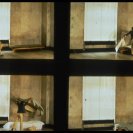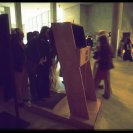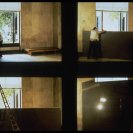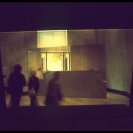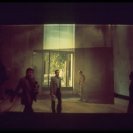With Theo Botschuijver.
This work created a collage of fictional events within a museum space by making projected images of the events appear contiguous with the real space and actual situations. The work was constituted by two structural elements: a large projection screen and an optical viewing console with an automated pair of slide projectors. Due to the screen's retro-reflective properties, the projected image could only be seen through the viewing console - from any other position in the room the screen was a plain grey surface. The inherent brightness of this projection system enabled it to be concurrent with the ambient lighting in the museum, meaning a coherent collage of the projected images with the surroundings was achieved. Furthermore, these images showed exactly that part of the museum room hidden by the screen, creating a seamless continuity between the virtual and actual spaces. Visitors walking by the screen were unaware they had entered and become part of the visual space of the projected image.
Twelve different events had been staged and photographed in the same museum area prior to the exhibition. These projected events were programmed in slides sequences that were triggered whenever a visitor stepped onto the viewing console - one of the twelve events was then shown. For example, one such projected event showed a visitor who made a bed for himself on a museum bench and then went to sleep on it. Another showed the projection screen itself being built up and gradually blocking the view of the museum space behind it. In other sequences a visitor was seen walking up to the museum window and smashing it with a pickaxe. Or the Venetian blind over the window was closed, blacking out only the projected part of the room.





